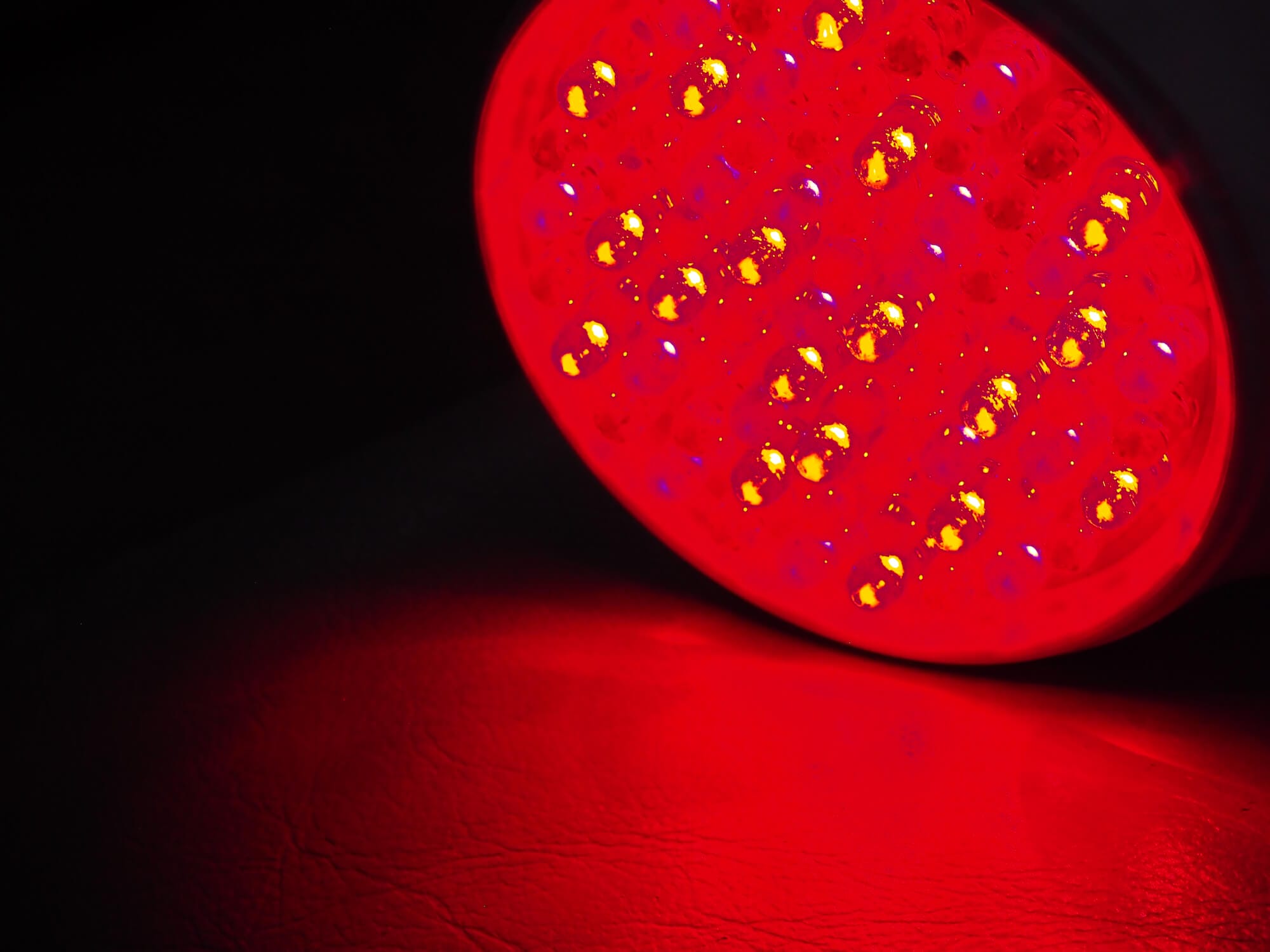Red light therapy (RLT) has become a popular tool among biohackers and wellness seekers because of its many purported health benefits. Supporters of red light therapy devices argue that the frequencies that make up red and infrared light promote skin health, slow down aging, speed up muscle recovery, improve sleep and reduce pain and inflammation.
In this article, I’ll dig into the scientific evidence behind these health claims and share my personal experience with the various red light therapy devices I’ve used to help treat workout-related injuries, improve my sleep and increase collagen production in my skin.
What Is Red Light Therapy?

Red light therapy leverages specific wavelengths of light in the red and infrared spectrum. These wavelengths trigger a response in the body at the molecular level.
Much like regular sunlight, red and near-infrared light can “stress” the body and force it to adapt and become more resilient. This “what doesn’t kill you makes you stronger” concept is known as hormesis, and I discuss it in more detail in my article on the health benefits of ice bathing.
One example of hormesis you’re likely familiar with is the tanning of your skin after prolonged sun exposure. By increasing melanin production, your body becomes more resilient to the stressor that is sunlight. That, in turn, reduces your risk of getting sunburned.
Fun fact: While red light therapy doesn’t increase melanin production (or cause burns), studies have shown that exposure to red and infrared light can precondition your skin and reduce your chances of getting a sunburn.
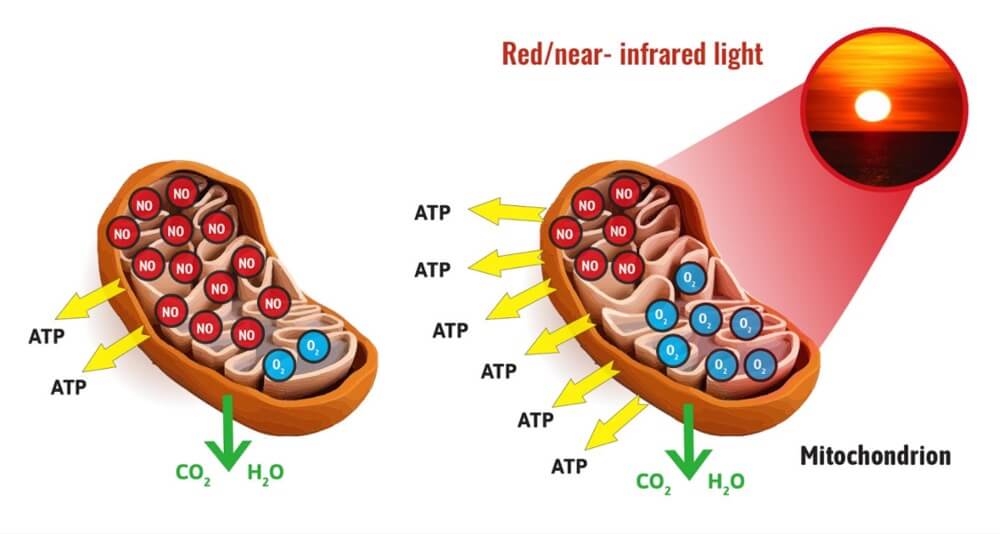
While there is still a lot we don’t know about the effects of red light therapy on the human body, scientists think that different wavelengths of light trigger biochemical effects in cells that strengthen the mitochondria (the cells’ power plants).
By strengthening the mitochondria, the cells can make more energy (in the form of adenosine triphosphate or ATP). With this increased energy, the cells can function more efficiently and better repair the damage inflicted by free radicals.
Types of Red Light Therapy

Red light therapy is a catch-all term that covers a variety of different technologies. For example, some red light therapy devices use light-emitting diodes (LEDs), some use lasers, and others use a combination of LED light and laser light.
Red light therapy devices also differ in the specific wavelengths they emit, the amount of energy they put out (which impacts how much light reaches the target area, known as irradiance) and more.
What’s important to understand is that the underlying technology of any given RLT device determines which health benefits you can expect to get from using it.
Without getting into the nitty-gritty of red light therapy technology, here’s a list of the different types of red light therapy devices you may encounter:
- Cold laser therapy.
- LED light therapy.
- Low level laser therapy or low level light therapy (LLLT).
- Low-power laser therapy (LPLT).
- Photobiomodulation (PBM).
- Photonic stimulation.
- Phototherapy.
- Soft laser therapy.
All of the device types above fall under the red light therapy umbrella, but they differ in how they emit light (i.e., LED vs. laser) and what frequencies of light they emit.
How to Choose the Right Red Light Therapy Device

Deciding which red light therapy device is right for you depends on the specific health outcomes you’re trying to achieve.
For example, LED-based devices that emit both red and infrared light are excellent for promoting skin health, speeding up muscle recovery and improving sleep. On the other hand, if you’re trying to use red light for reducing joint pain caused by an inflammatory condition such as rheumatoid arthritis or osteoarthritis, I recommend devices that leverage a combination of lasers and LEDs, such as the Kineon Move+ Pro.
If opting for an LED-based red light therapy device, make sure it covers the right wavelengths within the red and infrared light spectrum, outputs enough energy, and has a sufficiently-high irradiance to reach the target area.
As far as light spectrum coverage is concerned, I recommend devices that cover at least the 660 nm and 850 nm spectrum. However, budget permitting, I’d go with devices that also cover the 630 nm and 830 nm spectrum, which have been used in many clinical trials.
At home, I use red light therapy panels from Mito Red Light because they’re well-built, offer excellent irradiance with low EMF emissions, and cover a variety of wavelengths. To learn more about the specific red light panel I use, check out my Mito Red Light review.
Top 4 Red Light Therapy Benefits
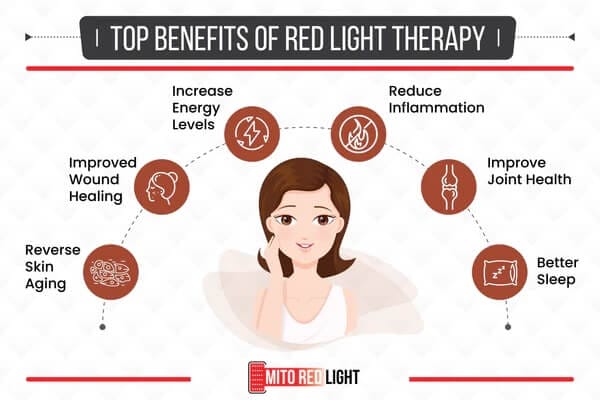
#1. Improves Skin Health
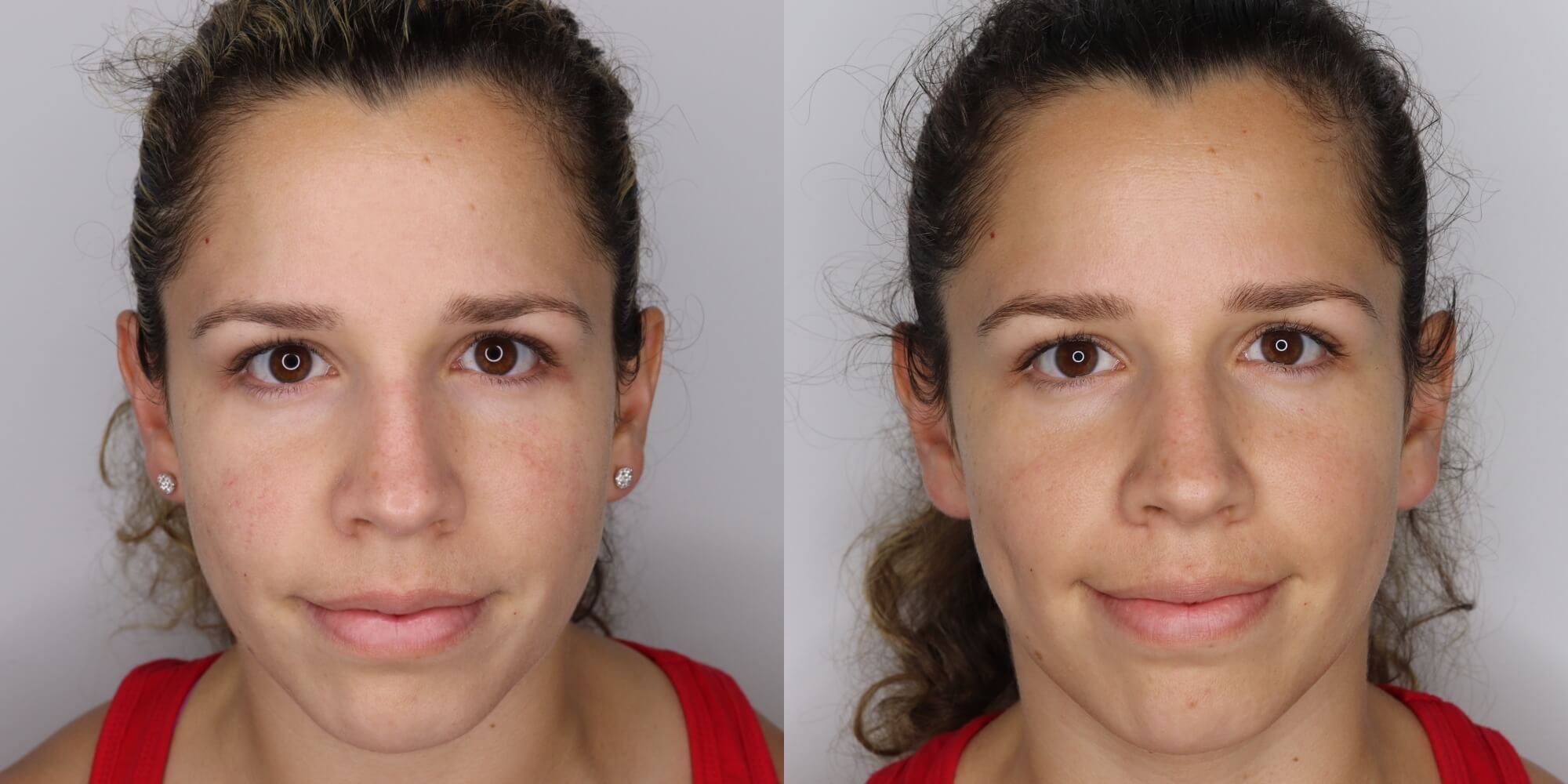
One of the most popular use cases for red light therapy is improving skin health. That’s why you often find red light therapy devices in dermatologist offices and the salons of medical professionals who specialize in anti-aging and related cosmetic procedures.
Studies have shown that certain light frequencies improve collagen production in the skin and increase skin thickness, which can reduce visible signs of aging by softening wrinkles and fine lines.
My wife has been using a SolaWave as part of her skincare routine and has seen impressive results (as shown in the photo above).
Studies have also shown that using a combination of red and infrared light before sun exposure can make the skin more resilient and reduce the chances of getting a sun burn. Additionally, some doctors use red light therapy to treat inflammatory skin conditions such as acne and psoriasis, as well as to speed up wound healing and tissue repair.
The basic principle behind all of these treatment applications is that red light therapy increases blood circulation in the skin, which provides extra oxygen and micronutrients to the affected tissue, thus allowing it to heal quicker.
On a molecular level, scientists believe that a molecule inside the mitochondria (called cytochrome C oxidase) absorbs the specific wavelengths in red light, which increases the cell’s energy production. That in turn, suppresses inflammation, which is thought to help reduce the symptoms of certain inflammatory skin conditions.
I’m a firm believer in addressing the root cause of inflammation rather than simply treating the symptoms. For example, inflammatory skin conditions are often caused by a leaky gut and a poor diet. By removing inflammatory foods from your diet — including processed carbs, industrial seed oils and most plants — you allow your skin to heal naturally.
At the same time, there’s nothing wrong with leveraging red light therapy to support and speed up the healing process. Just don’t rely on red light in lieu of making the appropriate lifestyle changes.
To learn more about how nutrition impacts your overall health (including skin health), check out the nutrition section of my healthy lifestyle guide.
Regarding using red light therapy devices to speed up wound healing, irradiation parameters (wavelength and dose) play a critical role, while the source of the light (i.e., LED vs. laser) is less important. In other words, you can achieve wound healing benefits from either LED or laser-powered devices, as long as the light they emit is strong enough and of the proper wavelength (between 600 nm and 1,300 nm).
#2. Speeds Up Muscle Recovery
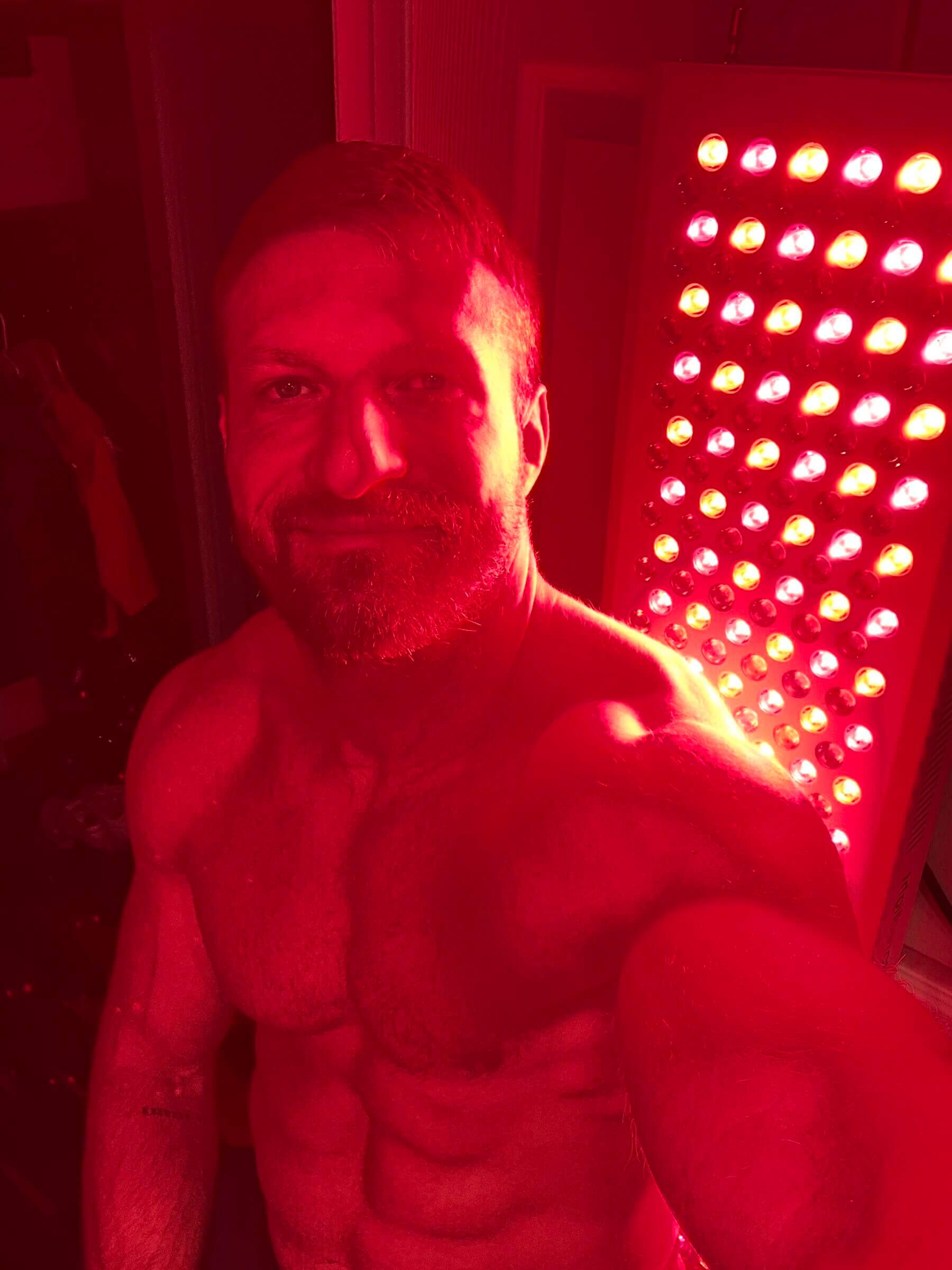
There is substantial evidence that red light therapy can improve athletic performance, both directly and indirectly. More specifically, studies have shown that red light can speed up muscle recovery via three related mechanisms, including:
- Reduced muscle damage.
- Reduced muscle fatigue.
- Improved muscle recovery after exercise.
The combination of these three mechanisms can help athletes recover more quickly from intense workouts or competitions.
Reduced Muscle Damage and Post-Exercise Recovery
Microscopic tears in muscle fibers are a natural and necessary aspect of growing muscle tissue and improving exercise performance. But if a workout (or competition) inflicts too much muscle damage, it can negatively impact your training schedule and your ability to perform in the days that follow.
A 2010 study published in The European Journal of Applied Physiology found that using low-level laser therapy (a form of red light therapy) before certain types of exercises reduces muscle damage markers. Another double-blind randomized placebo-controlled study, published in Lasers in Medical Science, found that using infrared light after exercise moderately decreased inflammatory markers in water polo players.
Besides reducing muscle damage, studies have shown that using red light therapy as part of a post-exercise routine can accelerate muscle recovery and can reduce muscle soreness, muscle strength loss and range of motion impairments for up to 96 hours after exercise.
Reduced Muscle Fatigue
Several clinical studies, including a 2014 randomized double-blind crossover trial published in Photomedicine and Laser Surgery, have found that using low-level laser therapy before, during and after intense exercise can improve fatigue resistance.
In other words, using red light therapy can help you crank out more repetitions before your muscles fatigue.
While the benefits of red light therapy in the context of reducing muscle damage, fatigue and recovery may not be relevant to the average fitness enthusiast or hobby athlete, they can certainly make a difference for competitive athletes who operate in an environment where every second or every repetition counts.
#3. Reduces Pain and Inflammation

As I discussed in detail in my article about using photobiomodulation to treat knee and joint pain, red light therapy can help reduce pain and inflammation by decreasing the expression of pro-inflammatory factors (such as IL-1β, IL-6, IL-10, COX-2 and IFN-γ) and increasing the expression of anti-inflammatory cytokines (such as IL-2, IL-4 and IL-13).
Additionally, red light therapy can reduce pain by degrading pain neurotransmitters (e.g., acetylcholine), by increasing serotonin and β-endorphin synthesis (important neurotransmitters related to pain relief), by suppressing bradykinin (neurotransmitter responsible for pain reception), and by downregulating the speed of neurotransmission.
In other words, red light therapy can block pain signals from reaching your brain while also releasing chemicals that make you feel better.
I recently tweaked a muscle close to my right shoulder blade that has been causing me uncomfortable pain (even while typing these lines). To help speed up the healing process and provide temporary pain relief, I’ve been using a combination of different red light therapy devices, including the MitoPro 1500, the Kineon Move+ Pro, the FLexBEAM and the Solio Alfa+.
Every time I use red light therapy, my pain subsides for an hour or two, enabling me to be more productive without getting distracted by the pain. Additionally, red light therapy has helped to improve oxygenated blood flow to the affected area, which speeds up the healing process of the damaged tissue.
#4. Improves Sleep

One valuable health benefit of red light therapy that I’ve only recently learned about is improved sleep quality.
There’s still a lot we need to learn about the mechanisms of how red light impacts sleep, but studies have shown that red light therapy can reduce the symptoms of certain mental health conditions like anxiety, which is one of the most common reasons why people have trouble falling asleep.
Another study involving 10 elite female basketball players discovered that full-body red light therapy increased serum melatonin levels, sleep quality and endurance performance. I suspect the latter was likely due to the improved sleep quality.
As you may know, melatonin is important for inducing sleep in general and for REM sleep in particular. The latter occurs predominantly during the second half of the night and is important for memory consolidation (among other things).
I’ve noticed an increase in both slow-wave (deep) sleep and REM sleep — as reported by my WHOOP Strap — since I started using the MitoPro 1500 red light therapy panel as part of my regular wellness routine.
Another benefit of red light therapy is that it decreases sleep inertia, which is the grogginess you feel right after waking up. So if you’re having trouble getting moving in the morning, red light therapy while sleeping or when you wake up might help.
Other Potential Benefits

Besides the red light treatment benefits outlined above, there are other (less researched) areas where scientists believe red light therapy could help.
For example, certain frequencies within the red light spectrum — specifically those between 635 nm and 680 nm — help to increase fat loss from fat cells (adipocytes) via the release of triglycerides. To that end, one study involving 40 healthy men and women showed that low-level laser therapy can help achieve safe and significant girth loss in only four weeks.
The extent to which at-home devices such as the Mito Red Light Advanced Red Light Therapy Belt (which my wife is currently testing) offer the same benefits as the devices used in clinical studies remains to be seen. Based on what I’ve learned so far about wearable red light therapy devices, they appear to be most effective when used right before an intense workout because the body can leverage the released triglycerides for energy instead of storing them as fat again.
In addition to the potentially beneficial aspects of red light therapy for weight loss, the technology has also shown promising results in the area of promoting hair growth.
A 2021 study discovered that red light therapy in the 650 nm spectrum promoted the proliferation of human hair follicles in a cultured-tissue model. While there is a chance that red light therapy doesn’t have the exact same effect in vivo, the findings are certainly promising.
Fortunately, I don’t suffer from hair thinning or hair loss. But if I did, I’d definitely try red light therapy in combination with other interventions, including scalp massages and increasing my intake in vitamins and minerals from whole-food sources.
Red Light Therapy vs. Natural Light Exposure
As you may know, the light emitted by the sun contains a broad spectrum of wavelengths, including red light (620 nm to 750 nm) and infrared light (780 nm to 1 mm). That leads some people to wonder whether it’s possible to expose skin to natural sunlight instead of using a red light therapy panel.
I’m a big believer in the benefits of exposing your eyes and naked skin to sunlight (without wearing sunglasses or sunscreen) several times a day, including sunrise, midday and sunset. Doing so can help you improve your vitamin D levels (which play a critical role in immune health), support your circadian rhythm and sleep better.
In fact, I would argue that natural light is the better option in most cases.
Unfortunately, not everyone has the opportunity to spend a significant amount of time in the sun. And if you don’t get enough sunlight while also being chronically exposed to artificial sources of blue light, you may not get sufficient exposure to wavelengths in the red and infrared light spectrum. While red light therapy is certainly not a replacement for regular sun exposure, it can help compensate and bridge some of the gaps.
The second reason why I recommend leveraging red light therapy is because both red and infrared light offer therapeutic benefits without the potential downsides of sun exposure (e.g., skin aging, sunburns and other types of sun damage).
For example, using a red light therapy device can help increase collagen production in the skin without incurring the damage that could come from sitting in the sun for an hour. The same principle applies to speeding up wound healing and treating inflammation in muscle tissue due to injury.
That’s why I combine daily but sensible sun exposure with regular red light therapy.g
Frequently Asked Questions

Below are answers to the most frequently asked questions about red light therapy and its health benefits. If you have any questions I haven’t covered in this review, I encourage you to leave a comment.
Both the skin and eyes have photoreceptors that get engaged by certain light frequencies. For example, both red light and infrared light stimulate a special molecule inside our cells (called cytochrome C oxidase) that causes the mitochondria to produce more energy.
By producing more energy, the affected cells function better and are better able to self-repair. That has several downstream effects, including thickening of the skin, becoming more resistant to sunburns, increased fibroblasts production (which causes an intradermal collagen density increase) and more.
Yes, red light therapy has numerous, scientifically-proven health benefits as outlined in this article. However, the efficacy of any red light therapy device is based on its underlying technology, the power output, emitted wavelengths and other factors.
In other words, not all red light therapy devices offer the same benefits and it’s important to carefully select the right device for the outcome you want to achieve.
Consumer-grade red light therapy devices are generally safe and don’t cause any significant side effects. However, some of the devices that incorporate near-infrared light or radio frequency (RF) can get quite hot and could cause reddening of the skin. Additionally, I recommend using safety goggles when treating your face to avoid exposing your naked eyes to too much red light, which could cause damage.
Both red and infrared light is generally safe for the eyes. Some studies have even found that red light can help improve your vision. However, many of the higher-quality red light panels are incredibly bright, making it impossible and painful to look directly into them for more than a few seconds. I recommend avoiding staring directly into light (regardless of its wavelength) if it hurts your eyes.
But if you can reduce the intensity or brightness of your red light therapy device and don’t find it painful to look directly into the light, you can likely do so without damaging your vision.
I have not seen any studies indicating that red or infrared light can harm expecting mothers or fetuses. However, I always recommend consulting a knowledgeable healthcare professional before starting a red light therapy treatment.
You’ll likely notice some of the benefits of red light therapy immediately, including increased blood flow in the targeted area. Other benefits, such as increased collagen production and a reduction of fine lines, wrinkles and inflammation, require regular treatments over a few weeks.
A study published in 2018 concluded that photodynamic therapy (a form of red and blue light therapy) is a non-scarring alternative for treating basal cell carcinoma (a form of skin cancer). The study specifically compared the effectiveness of blue light (400 nm) vs. red light (635 nm) therapy to treat basal cell carcinoma. Based on the findings, both forms of light therapy appear to be equally effective.
If you’ve been diagnosed with this type of skin cancer, I recommend talking to your healthcare provider to see if topical light therapy could be an option.
Yes. Red light therapy is generally safe for pets to help treat cuts and wounds, infections, inflammation, joint pain, strains and similar conditions you would also find in humans. While most scientific studies involving red light therapy and animals are focused on mice, I’ve found several studies involving dogs, cats and horses.
For example, one study involving quarter horses found that red light therapy was effective in relieving chronic back pain. Another blind randomized clinical trial conducted on dogs who underwent bone surgery concluded that preoperative low level laser light therapy helped the dogs heal quicker than those that received a placebo treatment.
If you’re considering using red light therapy with your pet, I recommend consulting with a knowledgeable vet first.
Studies on rats have discovered that exposing their testis to red light increased serum testosterone levels without causing any negative side effects. That’s likely the reason why some people in the biohacking community have started tanning their genitals.
Considering that exposing your genitals to red light (from artificial sources or natural sunlight) is non-invasive, there’s no reason not to give it a try.
Red Light Therapy Benefits: Summary & Final Thoughts
Research into red light therapy began in 1993, when NASA started using LEDs to help with plant growth in space. Since then, red light therapy has gained incredible popularity among medical professionals and wellness enthusiasts alike.
I first stumbled onto red light therapy when my wife began testing SolaWave, a skincare tool that can help reduce the appearance of wrinkles, fine lines, blemishes and dark circles. I was skeptical at first, but when I saw how much my wife’s skin had improved after just a few weeks of treatment, I began researching the benefits of red light therapy.
As part of my research, I began testing different devices to help me treat exercise-induced injuries, speed up muscle recovery and improve my sleep.
Based on all the scientific research I’ve seen and my own anecdotal evidence, I firmly believe that red light therapy is effective for the use cases outlined in this article.
I will continue using the devices at my disposal to improve my health and well-being while keeping an eye out for additional use cases.

Michael Kummer is a healthy living enthusiast and CrossFit athlete whose goal is to help people achieve optimal health by bridging the gap between ancestral living and the demands of modern society.
Medical Disclaimer
The information shared on this blog is for educational purposes only, is not a substitute for the advice of medical doctors or registered dieticians (which we are not) and should not be used to prevent, diagnose, or treat any condition. Consult with a physician before starting a fitness regimen, adding supplements to your diet, or making other changes that may affect your medications, treatment plan or overall health. MichaelKummer.com and its owner MK Media Group, LLC are not liable for how you use and implement the information shared here, which is based on the opinions of the authors formed after engaging in personal use and research. We recommend products, services, or programs and are sometimes compensated for doing so as affiliates. Please read our Terms and Conditions for further information, including our privacy policy.
